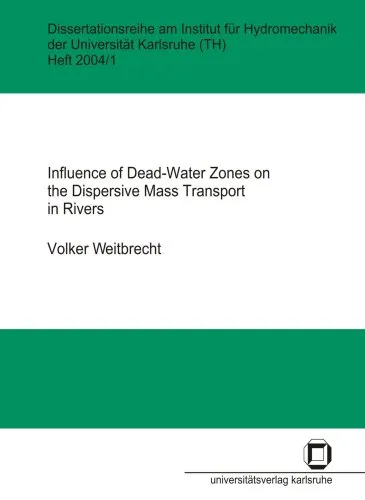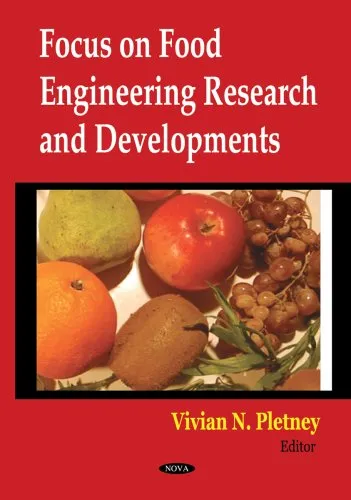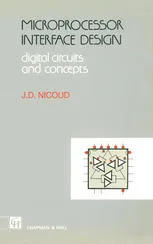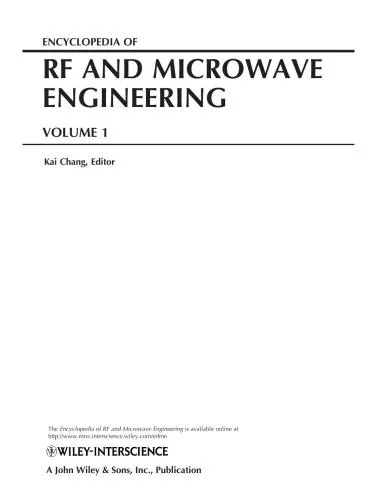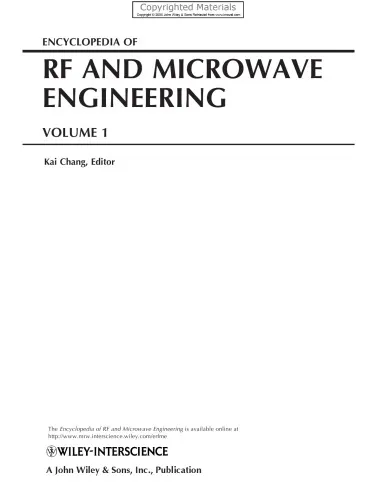Metabolic Engineering
4.7
بر اساس نظر کاربران

شما میتونید سوالاتتون در باره کتاب رو از هوش مصنوعیش بعد از ورود بپرسید
هر دانلود یا پرسش از هوش مصنوعی 2 امتیاز لازم دارد، برای بدست آوردن امتیاز رایگان، به صفحه ی راهنمای امتیازات سر بزنید و یک سری کار ارزشمند انجام بدینکتاب های مرتبط:
معرفی جامع کتاب Metabolic Engineering (صفحات 36—43)
کتاب Metabolic Engineering اثر نویسندگان Yu, Ai-Qun؛ Juwono, Nina Kurniasih Pratomo؛ Foo, Jee Loon؛ Leong, Susanna Su Jan؛ و Chang, Matthew Wook، یکی از منابع برجسته در حوزه مهندسی متابولیک است که در صفحات 36 تا 43، به تشریح عمیق مفاهیم کلیدی این علم پرداخته است. این اثر، با ترکیب دانش تئوری و کاربردهای عملی، به ویژه برای پژوهشگران، دانشجویان و فعالان صنعت بیوتکنولوژی، اهمیت ویژهای دارد. در این بخش از کتاب، تمرکز اصلی بر رویکردهای نوین اصلاح مسیرهای متابولیک، استفاده از ابزارهای ژنتیک و بیوانفورماتیک، و بهینهسازی تولید ترکیبات زیستی ارگانیک است.
خلاصه تفصیلی کتاب
صفحات 36 تا 43 کتاب Metabolic Engineering به عنوان یک نقطه عطف در روند آموزشی این اثر شناخته میشوند، چرا که خواننده را از مبانی مقدماتی وارد مرحله تحلیل و طراحی پیشرفته سیستمهای متابولیک میکند. نویسندگان با توضیح مفاهیم مهمی مانند Flux Balance Analysis، Gene Knockout و Adaptive Laboratory Evolution، این امکان را فراهم میآورند که فرد بتواند مسیرهای بیوشیمیایی در سلولهای میکروارگانیسمها را به شکلی دقیق کنترل و بهینهسازی کند.
این بخش، ابتدا به معرفی Platform Strains میپردازد و مفاهیم پایهای در خصوص انتخاب سویههای مناسب برای مهندسی متابولیک را بررسی میکند. سپس، تکنیکهای بهینهسازی از طریق دستکاری ژنتیکی و استفاده از دادههای اُمیکس (Omics Data) به تفصیل مورد بحث قرار میگیرد. نویسندگان با ذکر مثالهایی از تولید مواد زیستی مانند Biofuels و Bioplastics، نشان میدهند که چگونه تغییرات در ژنوم میتواند بازده تولید را تا چندین برابر افزایش دهد. این توضیحات، همراه با نمودارها و مدلهای ریاضی، سبب میشود خواننده درک عمیقتری از تاثیر هر تغییر در شبکه متابولیک داشته باشد.
نکات کلیدی
- تسلط بر استفاده از مدلهای محاسباتی برای پیشبینی رفتار شبکههای متابولیک.
- آشنایی با تکنیکهای اصلاح ژنتیکی پیشرفته مانند CRISPR و Gene Editing در مهندسی متابولیک.
- درک ارتباط بین دادههای Transcriptomics، Proteomics و Metabolomics در بهینهسازی تولید محصولات زیستی.
- تمرکز بر کاهش هزینههای تولید و افزایش بهرهوری فرآیندهای بیوتکنولوژی.
- شناخت چالشهای مقیاسپذیری (Scale-up) و راهحلهای صنعتی برای کاربردهای مستقیم.
جملات مشهور از کتاب
«مهندسی متابولیک، هنر تغییر مسیرهای زندگی در مقیاس سلولی است.»
«هر تغییر کوچک در شبکه متابولیک، میتواند آینده تولید صنعتی را متحول کند.»
چرا این کتاب اهمیت دارد؟
اهمیت کتاب Metabolic Engineering نه تنها در ارائه مفاهیم علمی دقیق بلکه در ارتباط مستقیم آن با نیازهای صنعتی معاصر نهفته است. در عصر حاضر که تولید پایدار و سبز مواد شیمیایی، انرژی و داروها به عنوان یک اولویت جهانی مطرح است، مهندسی متابولیک نقش کلیدی ایفا میکند. این کتاب با ارائه مثالهای واقعی از پروژههای موفق، پلی میان تحقیق و توسعه دانشگاهی و کاربرد صنعتی ایجاد میکند.
علاوه بر این، نویسندگان با استفاده از زبانی علمی اما روان، امکان درک مفاهیم پیچیده را برای خوانندگان با سطوح مختلف تخصص فراهم کردهاند. رویکرد آموزشی این کتاب مبتنی بر Problem-Solving بوده و خواننده را از مرحله یادگیری به مرحله اجرای عملی هدایت میکند. این امر باعث میشود که حتی صنعتگرانی که تجربه کمی در حوزه زیستفناوری دارند بتوانند با استفاده از این راهنمای عملی، پروژههای مهندسی متابولیک را با موفقیت پیادهسازی کنند.
نکته مهم دیگر این است که کتاب به صورت سیستماتیک به روشهای ارزیابی عملکرد فرآیندهای اصلاح شده پرداخته و ابزارهایی را معرفی میکند که میتوانند به طور مستقیم در محیط صنعتی مورد استفاده قرار گیرند. این ویژگی نه تنها جنبه آموزشی، بلکه جنبه کاربردی کتاب را تقویت میکند و آن را به یک منبع مرجع برای مدیران پروژهها، محققان و مهندسان تبدیل مینماید.
در نهایت، این اثر با پوشش مباحثی نظیر طراحی مسیرهای متابولیکی نوین، استفاده از دادههای عظیم (Big Data) در تحلیل زیستی، و ادغام هوش مصنوعی در پیشبینی نتایج اصلاحات ژنتیکی، جایگاه خود را به عنوان یکی از جامعترین منابع علمی در این حوزه به اثبات رسانده است.
Metabolic Engineering pp.36—43 is a pivotal section from the comprehensive scientific work authored by Yu Ai-Qun, Nina Kurniasih Pratomo Juwono, Foo Jee Loon, Leong Susanna Su Jan, and Chang Matthew Wook. This part of the book explores advanced concepts in metabolic pathway optimization, synthetic biology approaches, and the integration of systems biology into engineering of microorganisms. It highlights the crucial methodologies involved in manipulating cellular metabolism to achieve enhanced production of biochemical products, all while maintaining robustness and efficiency in industrial and laboratory settings. As such, it stands as an essential reference for researchers, academics, and professionals in biotechnology, bioengineering, and life sciences.
Detailed Summary of the Book Section
The section spanning pages 36 to 43 in Metabolic Engineering delves into targeted pathway optimization strategies that bridge the gap between theoretical designs and practical applications. Beginning with a discussion on metabolic flux analysis, the authors explain how precise quantification of pathway intermediates can steer optimization efforts. This is followed by applications of CRISPR-based genome editing to fine-tune gene expression, allowing for controlled metabolic outputs.
Moreover, the section addresses modular metabolic engineering, where pathways are divided into subunits for independent optimization. This modularity enhances the adaptability of engineered systems and supports iterative design cycles. The authors provide insights into dynamic pathway regulation through synthetic promoters and riboswitches, enabling real-time control over metabolite production.
There is a strong emphasis on computational modeling and simulation, particularly on how genome-scale metabolic models can predict the impact of modifications before laboratory implementation. By integrating omics data into these predictive models, researchers can make informed decisions on genetic interventions to achieve desired phenotypes. In addition, case studies illustrate how these approaches lead to increased yields of valuable compounds, reduced by-product formation, and improved scalability of microbial bioprocesses.
Key Takeaways
- Metabolic flux analysis is essential for identifying bottlenecks in biochemical pathways.
- CRISPR-based genome editing enables precise modifications, revolutionizing metabolic engineering workflows.
- Modular pathway optimization enhances flexibility and adaptability of engineered organisms.
- Dynamic control mechanisms, such as riboswitches, provide fine-tuned regulation in response to environmental signals.
- Computational models integrated with omics data improve the predictability and efficiency of metabolic engineering projects.
- Case studies demonstrate tangible improvements in production efficiency and industrial applicability.
Famous Quotes from the Book
While this section contains highly technical language rather than literary prose, several statements encapsulate the essence of the authors’ vision and scientific rigor:
"Metabolic engineering is not merely the adjustment of pathways; it is the orchestration of cellular functions toward a harmonized biochemical symphony."
"Genome-scale models are the map and compass for navigating the complexity of metabolic networks."
"Precision tools transform the art of strain design into a predictable and measurable science."
Why This Book Matters
This section of Metabolic Engineering reflects the forefront of biotechnology, where molecular biology meets computational sciences to design microorganisms capable of producing fuels, pharmaceuticals, and industrial chemicals more efficiently. The authors’ multidisciplinary approach—incorporating biological systems, mathematical modeling, and synthetic biology tools—provides a roadmap for the future of sustainable bio-production.
For professionals, it presents practical methodologies that can be applied directly to research and industrial projects. For academics, it offers a rich source of knowledge and case studies that illustrate theory in action. In the broader context, metabolic engineering stands as a pillar for addressing global challenges, including renewable energy generation, waste valorization, and sustainable manufacturing. By detailing actionable and proven strategies, pages 36–43 extend beyond theory to deliver tools and frameworks that can reshape industries.
In an age where bio-based solutions are increasingly critical for environmental and economic stability, the insights from this section are not only scientifically valuable but socially impactful. They empower scientists and engineers to craft precise, adaptive, and efficient bioprocesses that can meet the demands of an evolving world.
دانلود رایگان مستقیم
شما میتونید سوالاتتون در باره کتاب رو از هوش مصنوعیش بعد از ورود بپرسید
دسترسی به کتابها از طریق پلتفرمهای قانونی و کتابخانههای عمومی نه تنها از حقوق نویسندگان و ناشران حمایت میکند، بلکه به پایداری فرهنگ کتابخوانی نیز کمک میرساند. پیش از دانلود، لحظهای به بررسی این گزینهها فکر کنید.
این کتاب رو در پلتفرم های دیگه ببینید
WorldCat به شما کمک میکنه تا کتاب ها رو در کتابخانه های سراسر دنیا پیدا کنید
امتیازها، نظرات تخصصی و صحبت ها درباره کتاب را در Goodreads ببینید
کتابهای کمیاب یا دست دوم را در AbeBooks پیدا کنید و بخرید
1042
بازدید4.7
امتیاز0
نظر98%
رضایتنظرات:
4.7
بر اساس 0 نظر کاربران
Questions & Answers
Ask questions about this book or help others by answering
No questions yet. Be the first to ask!


